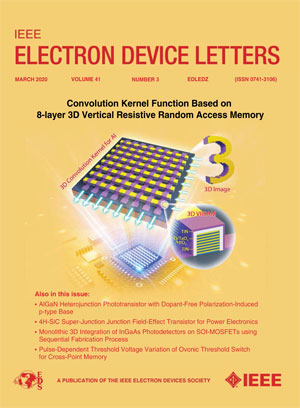Leakage Current Optimization Based on Conduction Paths Modulation by Interfacial Layer in Ge-Te OTS Selector
IF 4.1
2区 工程技术
Q2 ENGINEERING, ELECTRICAL & ELECTRONIC
引用次数: 0
Abstract
Ovonic threshold switch (OTS) selector plays an important role in suppressing the leakage current in 3D phase change memory. In this work, we optimized the OTS selector by applying an interfacial layer and proposed that the reduction of conduction paths explains how the interfacial layer affects the leakage current. The leakage current decreased by 120nA after applying the interfacial layer. The OTS selector with an interfacial layer maintains the same level of electrical performance in terms of speed and endurance. The devices show fast speed (6 ns) and good endurance (基于界面层传导路径调制的Ge-Te OTS选择器漏电流优化
在三维相变存储器中,卵形阈值开关(OTS)选择器在抑制漏电流方面起着重要作用。在这项工作中,我们通过应用界面层来优化OTS选择器,并提出了传导路径的减少解释了界面层如何影响泄漏电流。应用界面层后,泄漏电流降低120nA。具有界面层的OTS选择器在速度和耐久性方面保持相同的电气性能水平。器件速度快(6 ns),续航时间长($10^{{9}}\text{)}$。通过对漏电流、导通电流和漂移特性的对比分析,均说明了导通路径的减小。从Poole-Frenkel拟合得到的活化能来看,界面层在选择器中引入了一个势垒。考虑到泄漏电流的面积依赖性,我们提出泄漏电流的减小是由于导通路径的减少。这项工作有助于提高OTS选择器的性能,并为抑制OTS选择器中的泄漏电流提供了一种方法。
本文章由计算机程序翻译,如有差异,请以英文原文为准。
求助全文
约1分钟内获得全文
求助全文
来源期刊

IEEE Electron Device Letters
工程技术-工程:电子与电气
CiteScore
8.20
自引率
10.20%
发文量
551
审稿时长
1.4 months
期刊介绍:
IEEE Electron Device Letters publishes original and significant contributions relating to the theory, modeling, design, performance and reliability of electron and ion integrated circuit devices and interconnects, involving insulators, metals, organic materials, micro-plasmas, semiconductors, quantum-effect structures, vacuum devices, and emerging materials with applications in bioelectronics, biomedical electronics, computation, communications, displays, microelectromechanics, imaging, micro-actuators, nanoelectronics, optoelectronics, photovoltaics, power ICs and micro-sensors.
 求助内容:
求助内容: 应助结果提醒方式:
应助结果提醒方式:


